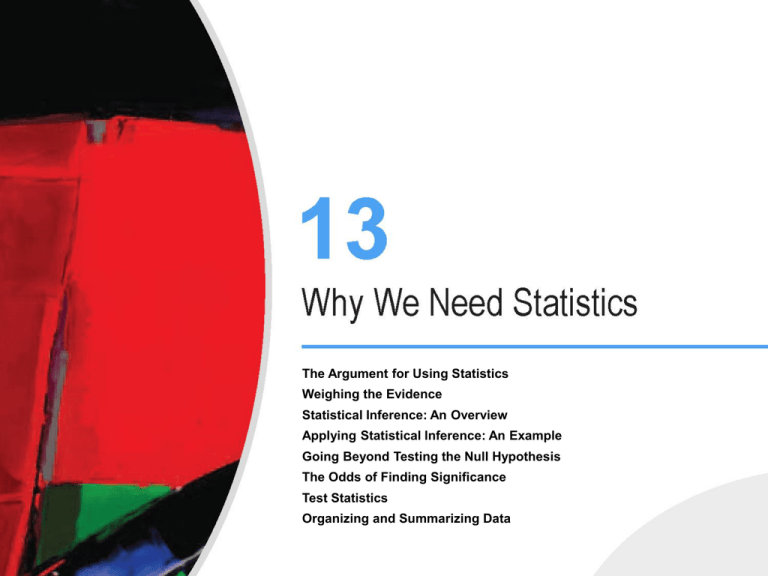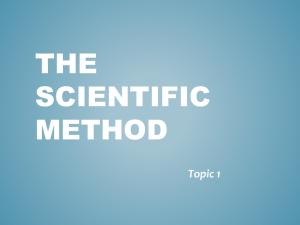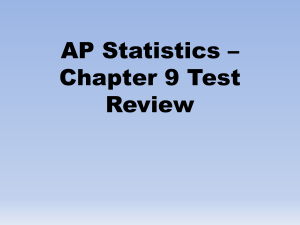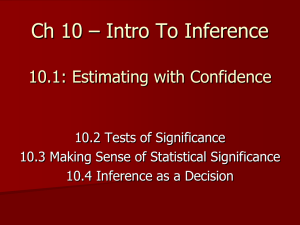Chapter 13
advertisement

The Argument for Using Statistics Weighing the Evidence Statistical Inference: An Overview Applying Statistical Inference: An Example Going Beyond Testing the Null Hypothesis The Odds of Finding Significance Test Statistics Organizing and Summarizing Data What are statistics? Statistics are quantitative measurements of samples. The Argument for Using Statistics What do statistics tell us? Descriptive statistics describe sample central tendency and variability. Inferential statistics allow us to draw conclusions about a parent population from a sample. Weighing the Evidence What point does the Ms. Adams story make about evaluating experimental data? Just as Detective Katz can at best show that Ms. Adams is probably guilty, in statistics we can only state that the independent variable probably affected the dependent variable. Weighing the Evidence What point does the Ms. Adams story make about evaluating experimental data? While we cannot prove that the independent variable definitely caused the change in the dependent variable, we can state the probability that our conclusion is correct. Weighing the Evidence Define sample and population. A population is a set of people, animals, or objects that share at least one characteristic in common (like college sophomores). A sample is a subset of the population that we use to draw inferences about the population. Statistical Inference: An Overview What is statistical inference? Statistical inference is the process by which we make statements about a parent population based on a sample. Statistical Inference: An Overview What does it mean when we conclude that our scores probably came from the same population? The differences in scores obtained from separate treatment groups are not significantly greater than what we might expect between any samples randomly drawn from this population. When researchers report this outcome, it means that were was no treatment effect. Statistical Inference: An Overview What is variability? For a set of dependent variable measurements, there is variability when the scores are different. Variability “spreads out” a sample of scores drawn from a population. Statistical Inference: An Overview What is variability? Which sample shown below has the most variability? Statistical Inference: An Overview What is the null hypothesis? The null hypothesis (H0) is the statement that the scores came from the same population and the independent variable did not significantly affect the dependent variable. Statistical Inference: An Overview What is statistical significance? Results are statistically significant when the difference between our treatment groups exceeds the normal variability of scores on the dependent variable. Statistical significance means that there is a treatment effect at an alpha level we have preselected, like .01 or .05. Statistical Inference: An Overview Explain the alternative hypothesis. The alternative hypothesis (H1) is the statement that the scores came from different populations the independent variable significantly affected the dependent variable. Statistical Inference: An Overview When may we reject the null hypothesis? We may reject the null hypothesis when the differences between treatment groups exceed the normal variability in the dependent variable at our chosen level of significance. Statistical Inference: An Overview What does a frequency distribution of scores reveal? The frequency distribution displays the number of individuals contributing a specific value of the dependent variable in a sample. Statistical Inference: An Overview What does a frequency distribution of scores reveal? The values of the dependent variable are indicated on the horizontal X-axis (abscissa) and the frequencies of these values are indicated on the vertical Y-axis (ordinate). You can calculate the total number of participants by adding the frequencies. Statistical Inference: An Overview Why does rejecting the null hypothesis depend on data variability? The decision to accept or reject the null hypothesis depends on whether the differences we measure between treatment groups are significantly greater than the normal variability among people in the population. Applying Statistical Inference: An Example Why does rejecting the null hypothesis depend on data variability? The greater the normal variability in the population, the larger the difference between groups required to reject the null hypothesis. Applying Statistical Inference: An Example Contrast directional and nondirectional hypotheses. A directional hypothesis predicts the “direction” of the difference between two groups on the dependent variable. For example: The experimental group will lower their systolic blood pressure more than the control group. Applying Statistical Inference: An Example Contrast directional and nondirectional hypotheses. A nondirectional hypothesis predicts that the two groups will have different values on the dependent variable: For example: The experimental group and control group will achieve different systolic blood pressure reductions. Applying Statistical Inference: An Example What is a significance level and how do we select one? The significance level (alpha) is our criterion for deciding whether to accept or reject the null hypothesis. Psychologists do not use a significance level larger than .05. Applying Statistical Inference: An Example What is a significance level and how do we select one? A significance level of .05 means that a pattern of results is so unlikely that it could have occurred by chance fewer than 5 times out of 100. Applying Statistical Inference: An Example What are Type 1 and Type 2 errors? A Type 1 error (a) is rejecting the null hypothesis when it is correct. The experimenter determines the risk of a Type 1 error by selecting the alpha level. A Type 2 error (b) is accepting the null hypothesis when it is false. Applying Statistical Inference: An Example How should we support null hypothesis testing? An American Psychological Association task force recommended that researchers include estimates of effect size and confidence intervals, in addition to p values. When you calculate a p value that is statistically significant, this means that your results are unlikely to be due to chance (are probably real). Going Beyond Testing the Null Hypothesis How should we support null hypothesis testing? Effect size estimates the strength of the association between the independent and dependent variable—the percentage of the variability in the dependent variable is due to the independent variable. Going Beyond Testing the Null Hypothesis How should we support null hypothesis testing? A confidence interval is a range of values above and below a sample mean that is likely to contain the population mean (usually 95% or 99% of the time). Going Beyond Testing the Null Hypothesis What is a critical region? A critical region is a region of the distribution of a test statistic sufficiently extreme to reject the null hypothesis. For example, if our criterion is the .05 level, the critical region consists of the most extreme 5% of the distribution. The Odds of Finding Significance What is a critical region? To reject the null hypothesis, the test statistic would have to fall within the shaded critical region. The Odds of Finding Significance What are one-tailed and two-tailed tests? A one-tailed test has a critical region at one tail of the distribution. We use a one-tailed test with a directional hypothesis. A two-tailed test has two critical regions, found at opposite ends of the distribution. We use a two-tailed test with a nondirectional hypothesis. The Odds of Finding Significance What is the function of inferential statistics? Inferential statistics allow us to predict the behavior of a population from a sample. Examples of inferential statistics are the t test and F test. Test Statistics









